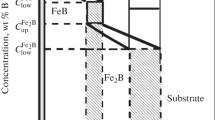Abstract
Boronizing treatment of ferrous materials has been widely employed by industry as a surface-strengthening technology for inhibition of corrosion, wear and erosion. Pack boronization using a pack composition that produces a graded boride microstructure has been studied using AISI 1018 and 1045 steels. Carbon in these alloys creates a resistance to boron diffusion because a carbon-enriched zone forms in front of the boride layen
The carbon concentration at the boride/pearlite interface was found to be as high as 3.0% in AISI 1045 steel. No significant layer phenomena could be distinguished inside the boron layer using the pack composition developed during this research. This result is significant because a graded microstructure with a continuous variation of the boron composition has been produced. Evidence developed during this study suggests that the boride layer consists of a mixture of FeB, Fe2B, and FeBx, which is probably FeB19. Analysis determined a measure of the resistance of carbon to boron diffusion at the boride/pearlite interface.
Access this article
We’re sorry, something doesn't seem to be working properly.
Please try refreshing the page. If that doesn't work, please contact support so we can address the problem.
Similar content being viewed by others
References
L.S. Lyakhovich and S.S. Bragilevskaya, Effects of Bonding on the Oxidation Resistance of Steel,Protective Coatings on Metals, Vo1 2, G.V Samsonov, Ed., Consultants Bureau, 1969, p 123–127
W. Fichtl, Boronizing and Its Practical Applications,Mater Eng., VOL 2, 1981, p 276–286
R.H. Biddulph, Boronizing for Erosion Resistance,Thin Solid Films, Vol 45, 1977, p 341–347
N. Tripas and C. Perez-Perez, ABoronizing Treatment for Low-Carbon Steels,J. Mater Sci. Lett., Vol 1, 1982, p 298–299
P Goeriot, F. Thevenot, and J.H. Driver, Surface Treatment of Steel: Borudif, ANew Bonding Process,Thin Solid Films, Vol 78, 1981, p 67–76
S.R. Madhusudan, “Bonding of Steels,” M.S. thesis, South Dakota School of Mines & Technology, 1992
L. Qian, “A Study of the Behavior of Boron Diffusion in Plain Carbon Steel,” M.S. thesis, South Dakota School of Mines & Technology, 1993
Metallography, Structures and Phase Diagrams, Vol 8, 8th ed.,Metals Handbook, American Society for Metals, 1973, p 270–272
I.S. Dukarevich and M.Y Mozharov, ARadioactive Isotope Study of Carbon Redistribution in the Bonded Layer,Protective Coatings on Metals, Vo1 4, G.V Samsonov, Ed., Consultants Bureau, 1969, p 31–33
CM. Brakman, A.WJ. Gommers, and E.I. Mittemaijir, Bonding Fe and Fe-C, Fe-Cr and Fe-Ni Alloys: Boride-Layer Growth Kinetics,J. Mater Res., Vol 4 (No. 6), 1989, p 1354–1370
J.I. Goldstein, D.E. Newbury, P Echlin, D.C. Joy, C. Fiori, and E. Lifshin,Scanning Electron Microscopy and X-Ray Microanalyis: A Text for Biologists, Materials Scientists, and Geologists, Plenum Press, 1981, p 306
Author information
Authors and Affiliations
Rights and permissions
About this article
Cite this article
Qian, L.L., Stone, G.A. A study of the behavior of boron diffusion in plain carbon steels. JMEP 4, 59–62 (1995). https://doi.org/10.1007/BF02682706
Published:
Issue Date:
DOI: https://doi.org/10.1007/BF02682706




